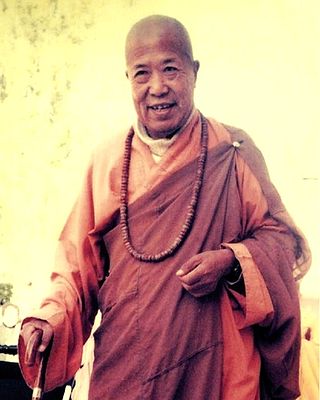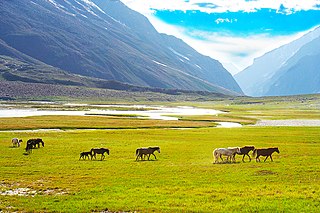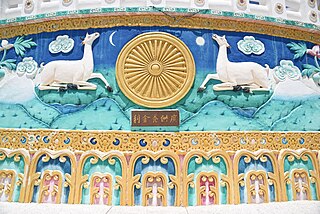
Shaolin Monastery, also known as Shaolin Temple, is a renowned monastic institution recognized as the birthplace of Chan Buddhism and the cradle of Shaolin Kung Fu. It is located at the foot of Wuru Peak of the Songshan mountain range in Dengfeng County, Henan Province, China. The name reflects its location in the ancient grove of Mount Shaoshi, in the hinterland of the Songshan mountains. Mount Song occupied a prominent position among Chinese sacred mountains as early as the 1st century BC, when it was proclaimed one of the Five Holy Peaks. It is located some 48 km (30 mi) southeast of Luoyang, the former capital of the Northern Wei Dynasty (386–534), and 72 km (45 mi) southwest of Zhengzhou, the modern capital of Henan Province.
The purpose of this timeline is to give a detailed account of Buddhism from the birth of Gautama Buddha to the present.

Fo Guang Shan Hsi Lai Temple is a mountain monastery in the northern Puente Hills, Hacienda Heights, Los Angeles County, California. The name Hsi Lai means "coming west".
The Drukpa or Drukpa Kagyu lineage, sometimes called Dugpa in older sources, is a branch of the Kagyu school of Tibetan Buddhism. The Kagyu school is one of the Sarma or "New Translation" schools of Tibetan Buddhism. The Drukpa lineage was founded in the Tsang region of Tibet by Tsangpa Gyare (1161–1211), and later became influential in Ladakh and Bhutan. It is one of several lineages known as "Red Hat sects".

Drikung Kagyü or Drigung Kagyü is one of the eight "minor" lineages of the Kagyu school of Tibetan Buddhism. "Major" here refers to those Kagyü lineages founded by the immediate disciples of Gampopa (1079-1153), while "minor" refers to all the lineages founded by disciples of Gampopa's main disciple, Phagmo Drupa (1110-1170). One of these disciples, Jigten Sumgön (1143-1217), is the founder of Drikung.

Hsuan Hua, also known as An Tzu, Tu Lun and Master Hua by his Western disciples, was a Chinese monk of Chan Buddhism and a contributing figure in bringing Chinese Buddhism to the United States in the late 20th century.

Chin Kung AM was a Chinese Buddhist monk and scholar from the Mahayana tradition. He was the founder of the Corporate Body of the Buddha Educational Foundation, an organization based on the teachings of Pure Land Buddhism. He was known for his teaching of Pure Land Buddhism and work in promoting inter-faith harmony in Australia and the Asia-Pacific region.
A Dharma name or Dhamma name is a new name acquired during both lay and monastic Buddhist initiation rituals in Mahayana Buddhism and monastic ordination in Theravada Buddhism. The name is traditionally given by a Buddhist monastic, and is given to newly ordained monks, nuns and laity. Dharma names are considered aspirational, not descriptive.

The Suru Valley is a valley in the Kargil District in the Union Territory of Ladakh, India. It is drained by the Suru River, a tributary of the Indus River. The valley's most significant town is Sankoo.

Ladakh Buddhist Association (LBA) is an organization in Ladakh, India concerned with interests of Buddhists in Ladakh. It was founded in 1933 by King Jigmet Dadul Namgyal, Kalon Tsewang Rigzin, Kalon Bankapa Morup Gyaltsan and Munshi Sonam Tsewang.
Shi Yongxin is the current abbot of the Shaolin Temple. He is the thirteenth successor after Shi Xingzheng. He is the Chairman of the Henan Province Buddhists Association, a representative of the Ninth National People's Congress and also one of the first Chinese monks ever to get an MBA degree.

The Gyalwang Drukpa is the honorific title of the head of the Drukpa Kagyu lineage, one of the independent Sarma (new) schools of Vajrayana Buddhism. This lineage of reincarnated masters started from Tsangpa Gyare, the first Gyalwang Drukpa and founder of the school. The 12th Gyalwang Drukpa, Jigme Pema Wangchen, is the current lineage holder. He was born at Lake Rewalsar, India in 1963.
Rizong gompa, Gelugpa or Yellow Hat Buddhist monastery is also called the Yuma Changchubling in Ladakh, India. It is situated at the top of a rocky side valley on the north side of the Indus, to the west of Alchi on the way to Lamayuru. It was established in 1831 by Lama Tsultim Nima under the Gelukpa order, at Ri-rdzong. There are 40 monks in the monastery. The monastery is also called "the paradise for meditation" and is noted for its extremely strict rules and standards. The nunnery, located about 2 km from the monastery, is called the "Jelichun Nunnery" or Chulichan (Chomoling), where, at present, 20 nuns reside.

Thiksey Monastery or Thiksey Gompa is a Buddhist monastery affiliated with the Gelug school of Tibetan Buddhism. It is located on top of a hill in Thiksey approximately 19 kilometres (12 mi) east of Leh, in the Ladakh region of northern India. It is noted for its resemblance to the Potala Palace in Lhasa, Tibet, and is the largest monastery in central Ladakh, notably containing a separate set of buildings for female renunciates that has been the source of significant recent building and reorganization.
The 12th Gyalwang Drukpa, Jigmet Pema Wangchen, is the head of the Drukpa Lineage school, which is one of the independent Sarma (new) schools of Tibetan Buddhism. In Drukpa, druk means 'dragon' which is a symbol of love and peace.

Shanti Stupa is a Buddhist white-domed Stupa (chorten) on a hilltop in Chanspa, Leh district, Ladakh, in north India. It was built in 1991 by Japanese Buddhist Bhikshu, Gyomyo Nakamura. The Shanti Stupa holds the relics of the Buddha at its base, enshrined by the 14th Dalai Lama. The Stupa has become a tourist attraction not only due to its religious significance but also due to its location which provides panoramic views of the surrounding landscape.
Ng Mui (Chinese: t 伍枚, p Wú Méi; Cantonese: Ng5 Mui4) is said to have been one of the legendary Five Elders—survivors of the destruction of the Shaolin Temple by the Qing Dynasty.

Dharmachāri Gurumā was a Nepalese anagarika who was an influential figure in the revival of Theravada Buddhism in Nepal. She was expelled from Kathmandu by the government for her religious activities.

Xuecheng is a Chinese Buddhist monk, a former member of the National Committee of the Chinese People's Political Consultative Conference, and a popular blogger. He was president of the Buddhist Association of China from 2015 to 2018 when he resigned after allegations that he had engaged in corruption and sexual assault surfaced. He was ordered to be punished by the National Religious Affairs Administration after they corroborated the allegations.

The Kung Fu Nuns are an order of Buddhist nuns who belong to the Drukpa Kagyu lineage, a thousand-year-old sect led by the Gyalwang Drukpa. Their name comes from the order’s proficiency in Chinese martial arts, which they began learning in 2008 after the 12th Gyalwang Drukpa authorised training for them despite centuries-old Buddhist laws banning exercise for nuns.













